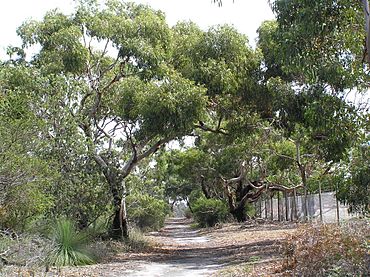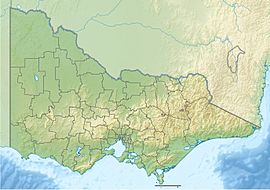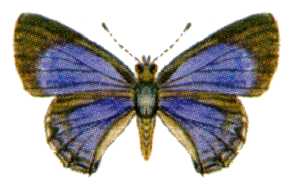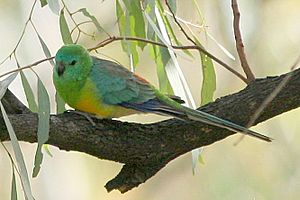Ocean Grove Nature Reserve facts for kids
Quick facts for kids Ocean Grove Nature ReserveVictoria |
|
|---|---|

Reserve walking track
|
|
| Nearest town or city | Ocean Grove |
| Established | 1971 |
| Area | 1.43 km2 (0.6 sq mi) |
| Managing authorities | Parks Victoria |
| Website | Ocean Grove Nature Reserve |
The Ocean Grove Nature Reserve is a special protected area in Victoria, Australia. It's about 1.43 square kilometers big. You can find it near Ocean Grove town, on the Bellarine Peninsula. It's also about 25 km south-east of Geelong city.
This reserve is super important because it's the only large piece of native woodland left on the Bellarine Peninsula. This woodland looks much like it did before European settlers arrived. Back then, a lot of land was cleared for farms and towns. The reserve is now surrounded by farms and houses. Parks Victoria looks after this amazing place. Studying the birds here helps us understand how isolated woodlands change over time.
Contents
History of the Reserve
The idea for the Ocean Grove Nature Reserve started in 1962. The Geelong Field Naturalists Club and its president, Jack Wheeler, helped form a committee. Their goal was to raise money to buy a piece of untouched bushland. They wanted to protect it from being built on.
They successfully raised enough money to buy the first 81 hectares. The reserve officially opened to the public in 1971. A few years later, in 1973, they bought another 62 hectares. This new land, which was partly cleared, became the eastern part of the reserve.
Since the reserve was created, many improvements have been made. Workers built a central wetland and walking tracks. They also added bird hides, an information center, a carpark, and a picnic area. The woodland has grown thicker over the years.
However, the reserve has faced some challenges. There has been damage from fires started on purpose. Also, firebreaks built to control fires have caused some harm. A long dry period from 2000 to 2003 killed many eucalypt trees. After this drought, fewer flowers grew, and there were fewer honeyeater birds.
Plants and Animals
Plants of the Reserve
The reserve has different types of plant areas. You can find eucalypt woodlands with tall Austral grasstrees. There are also coastal manna gums and drooping sheoaks. A very special and endangered plant here is the Bellarine form of yellow gum.
Other trees scattered around include black sheoaks and different kinds of wattles. These include black wattles, golden wattles, and prickly hedge wattles. You can also see coast tea-trees and silver banksias. A list of plants found here includes 178 different species. Amazingly, 22 of these are types of orchids!
Animals of the Reserve
Many land mammals live in the reserve. You might spot red-necked wallabies and swamp wallabies. Short-beaked echidnas, which are spiky, also live here. At night, common ringtail and brushtail possums are active. Various kinds of bats also fly around after dark. Sometimes, Koalas are seen in the trees.
Reptiles like lowland copperhead snakes live here. Several types of lizards are also present. These include blue-tongued skinks and jacky dragons. Sadly, a special butterfly called the small ant-blue used to live here. It is now believed to be gone from the reserve. This happened because its habitat was disturbed.
Birds of the Reserve
The reserve has always been a popular spot for birdwatchers. A report from 2004 looked at bird records from 1970 to 2005. It listed 167 different bird species seen in the reserve. Of these, 57 species were confirmed to have bred there.
Some birds that used to live in the reserve are now gone. These include the bush stone-curlew and grey-crowned babbler. They have disappeared from the entire Bellarine Peninsula. Other woodland birds have also decreased or vanished over 35 years. These include white-throated treecreepers, buff-rumped thornbills, scarlet robins, varied sittellas, and restless flycatchers.
However, some birds have become more common in the reserve. These include collared sparrowhawks, little corellas, and red-rumped parrots. Noisy miners and introduced birds like spotted doves, European greenfinches, and common mynas have also increased. With the new wetland and other water spots, many waterbirds have also started to visit.
Experts have noted that even though the woodland has been isolated for a long time, some bird declines happened recently. Bird numbers can slowly drop, reaching a critical point years after changes to the landscape. The final disappearance might seem sudden, but the problems started long ago. Birds might survive in less-than-perfect homes for a while. But some groups may eventually become too small to survive. This can happen due to low numbers, limited movement, or less successful breeding. Birds in woodlands that are cut off by clearing are especially at risk during dry periods. If a woodland is very isolated, lost bird groups are unlikely to return from outside areas.
Despite these challenges, the reserve is still very important. It acts as a resting place for birds moving locally or migrating. This includes types of striated pardalotes, grey fantails, and silvereyes that breed in Tasmania. Other birds that visit seasonally or pass through include rufous fantails and flame robins. You can also see yellow-faced and white-naped honeyeaters, and mistletoebirds.
The experts conclude that the reserve is like an "island" of original Bellarine Peninsula woodland. It is still very valuable, not just for birds, but for all its plants, mammals, and insects. It's a living example of a threatened natural community. Since it was created, it has helped teach the community about nature. It stands as a tribute to the people who started it and the volunteers who continue their work.
See also
 In Spanish: Reserva natural de Ocean Grove para niños
In Spanish: Reserva natural de Ocean Grove para niños






